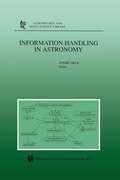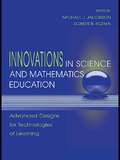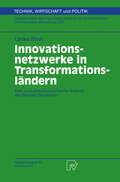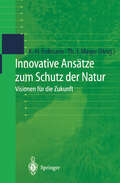- Table View
- List View
In Living Color: Protocols in Flow Cytometry and Cell Sorting (Springer Lab Manuals)
by Rochelle A. Diamond Susan DeMaggioA contribution towards making this increasingly valuable technology accessible to researchers, including the students, post-doctoral scholars, and technicians gathering the knowledge inherent in this integration between analysis and physical isolation/purification methodologies. A step-by-step approach to the methodology for measuring various attributes demonstrated in the particular cells of interest is provided, as is a myriad of resources to fuel the curiosity and answer questions of both new and adept users. This book stems from the editors'experiences managing flow cytometry/cell sorting core facilities for the emerging researchers, in particular in developmental, cellular, and molecular biology.
In Our Own Image: Personal Symmetry in Discovery
by Istvan Hargittai Magdolna HargittaiThe title of our volume refers to what is well described by the following two quota tions:"Godcreated man in his own image"l and "Man creates God in his own image."2 Our approach to symmetry is subjective, and the term "personal" symmetry reflects this approach in our discussion of selected scientific events. We have chosen six icons to symbolize six areas: Kepler for modeling, Fuller for new molecules, Pauling for helical structures, Kitaigorodskii for packing, Bernal for quasicrystals, and Curie for dissymmetry. For the past three decades we have been involved in learning, thinking, speaking, and writing about symmetry. This involvement has augmented our principal activities in molecular structure research. Our interest in symmetry had started with a simple fascination and has evolved into a highly charged personal topic for us. At the start of this volume, we had had several authored and edited symmetry related books behind 3 us. We owe a debt of gratitude to the numerous people whose interviews are quoted 4 in this volume. We very much appreciate the kind and gracious cooperation of Edgar J. Applewhite (Washington, DC), Lawrence S. Bartell (University of Michigan), R.
In Situ Hybridization Protocols (Methods in Molecular Biology #123)
by Ian A. DarbyThe technique of in situ hybridization, in its various forms, has been used routinely in many laboratories for a number of years. However, in situ hybridization has retained a reputation as one of the more difficult molecular biological techniques. This may be caused, in part, by the hybrid nature of the technique, which often requires a mixture of molecular biological and histological skills. The two techniques are usually taught and acquired in different streams of biolo- cal science. The step-by-step and detailed protocols provided in this book, by researchers active in the field, should make it possible for both the molecular biologist with little experience of histology and the histologist with little experience of molecular biology to use the technique successfully in their laboratories. In Situ Hybridization Protocols aims to provide useful protocols for two groups of researchers who use the technique: those who use in situ hybridi- tion to localize genes to particular chromosomes and those researchers who use DNA or RNA probes to localize expression of mRNA in tissue. This new edition also encompasses a number of techniques not covered in the previous edition, such as in situ hybridization of whole-mount embryo specimens, in situ hybridization at the electron microscopic level, and in situ detection of DNA fragmentation in apoptosis. The final two chapters of the book provide examples of application of in situ hybridization techniques to research and clinical problems.
Industrial Waste Treatment Processes Engineering: Specialized Treatment Systems, Volume III
by Gaetano CelenzaIndustrial Waste Treatment Process Engineering is a step-by-step implementation manual in three volumes, detailing the selection and design of industrial liquid and solid waste treatment systems. It consolidates all the process engineering principles required to evaluate a wide range of industrial facilities, starting with pollution prevention and source control and ending with end-of-pipe treatment technologies.Industrial Waste Treatment Process Engineering guides experienced engineers through the various steps of industrial liquid and solid waste treatment. The structure of the text allows a wider application to various levels of experience. By beginning each chapter with a simplified explanation of applicable theory, expanding to practical design discussions, and finishing with system Flowsheets and Case Study detail calculations, readers can "enter or leave" a section according to their specific needs. As a result, this set serves as a primer for students engaged in environmental engineering studies AND a comprehensive single-source reference for experienced engineers. Industrial Waste Treatment Process Engineering includes design principles applicable to municipal systems with significant industrial influents. The information presented in these volumes is basic to conventional treatment procedures, while allowing evaluation and implementation of specialized and emerging treatment technologies.What makes Industrial Waste Treatment Process Engineering unique is the level of process engineering detail. The facility evaluation section includes a step-by-step review of each major and support manufacturing operation, identifying probable contaminant discharges, practical prevention measures, and point source control procedures. This theoretical plant review is followed by procedures to conduct a site specific pollution control program. The unit operation chapters contain all the details needed to complete a treatment process design.Industrial Waste Treatment Process Engineering will interest environmental engineers, chemical process engineers working in environmental engineering, civil engineers with environmental specialties, as well as graduate students in environmental engineering, corporate environmental engineers, plant engineers, and industry and university technical libraries. These books supplement existing texts detailing the regulatory, legal, and permit preparation requirements imposed on manufacturing facilities. Additionally, Industrial Waste Treatment Process Engineering is designed for engineers preparing environmental appropriations for corporate funding and developing systems for plant facilities sensitive to operating costs.
Industrial Waste Treatment Processes Engineering: Specialized Treatment Systems, Volume III
by Gaetano CelenzaIndustrial Waste Treatment Process Engineering is a step-by-step implementation manual in three volumes, detailing the selection and design of industrial liquid and solid waste treatment systems. It consolidates all the process engineering principles required to evaluate a wide range of industrial facilities, starting with pollution prevention and source control and ending with end-of-pipe treatment technologies.Industrial Waste Treatment Process Engineering guides experienced engineers through the various steps of industrial liquid and solid waste treatment. The structure of the text allows a wider application to various levels of experience. By beginning each chapter with a simplified explanation of applicable theory, expanding to practical design discussions, and finishing with system Flowsheets and Case Study detail calculations, readers can "enter or leave" a section according to their specific needs. As a result, this set serves as a primer for students engaged in environmental engineering studies AND a comprehensive single-source reference for experienced engineers. Industrial Waste Treatment Process Engineering includes design principles applicable to municipal systems with significant industrial influents. The information presented in these volumes is basic to conventional treatment procedures, while allowing evaluation and implementation of specialized and emerging treatment technologies.What makes Industrial Waste Treatment Process Engineering unique is the level of process engineering detail. The facility evaluation section includes a step-by-step review of each major and support manufacturing operation, identifying probable contaminant discharges, practical prevention measures, and point source control procedures. This theoretical plant review is followed by procedures to conduct a site specific pollution control program. The unit operation chapters contain all the details needed to complete a treatment process design.Industrial Waste Treatment Process Engineering will interest environmental engineers, chemical process engineers working in environmental engineering, civil engineers with environmental specialties, as well as graduate students in environmental engineering, corporate environmental engineers, plant engineers, and industry and university technical libraries. These books supplement existing texts detailing the regulatory, legal, and permit preparation requirements imposed on manufacturing facilities. Additionally, Industrial Waste Treatment Process Engineering is designed for engineers preparing environmental appropriations for corporate funding and developing systems for plant facilities sensitive to operating costs.
Industrieforschung in den neuen Bundesländern (Technik, Wirtschaft und Politik #42)
by Franz Pleschak Michael Fritsch Frank StummerInelastic Analysis of Structures under Variable Loads: Theory and Engineering Applications (Solid Mechanics and Its Applications #83)
by Dieter Weichert Giulio MaierThe question whether a structure or a machine component can carry the applied loads, and with which margin of safety, or whether it will become unserviceable due to collapse or excessive inelastic deformations, has always been a major concern for civil and mechanical engineers. The development of methods to answer this technologically crucial question without analysing the evolution of the system under varying loads, has a long tradition that can be traced back even to the times of emerging mechanical sciences in the early 17th century. However, the scientific foundations of the theories underlying these methods, nowadays frequently called "direct", were established sporadically in the Thirties of the 20th century and systematically and rigorously in the Fifties. Further motivations for the development of direct analysis techniques in applied mechanics of solids and structures arise from the circumstance that in many engineering situations the external actions fluctuate according to time histories not a priori known except for some essential features, e.g. variation intervals. In such situations the critical events (or "limit states") to consider, besides plastic collapse, are incremental collapse (or "ratchetting") and alternating plastic yielding, namely lack of "shakedown". Non evolutionary, direct methods for ultimate limit state analysis of structures subjected to variably-repeated external actions are the objectives of most papers collected in this book, which also contains a few contributions on related topics.
The Inferior Oilvary Complex (Advances in Anatomy, Embryology and Cell Biology #155)
by Anastasia Bozhilova-Pastirova Wladimir A. OvtscharoffAlthough many studies have established the connections of the inferior olivary complex, there have been relatively few studies on the morphology of this nuclear complex. On the base of the similar topographic relations and connections with the cerebellum, the inferior olivary complex is regarded as homologous in all vertebrates. We present comprehensive light microscopical qualitative and quantitative analysis of the inferior olivary complex of different representatives of submammalian and mammalian vertebrates, including human. A detailed comparison was made at the structural level. Cytoarchitecture and cellular morphology of the inferior olivary complex have been studied in several submammalian (carp, frog, lizard, tortoise, pigeon) and mammalian species (rat, cat, and for the first time ground squirrel Citellus citellus L), including human.
Inflammatory Diseases of the Orbit: Clinical Features · Radiology Differential Diagnosis
by Renate Unsöld Gabriele GreevenStructured in a practical fashion, in that the clinical features and diagnostic imaging of each individual case are presented together, this richly illustrated volume is an invaluable daily reference for clinicians and practitioners in ophthalmology, otorhinolaryngology and radiology.
Inflammatory Processes: Molecular Mechanisms and Therapeutic Opportunities (Progress in Inflammation Research)
by Douglas W. Morgan L. GordonLettsIn November 1998 many of the key leaders of new drug discovery for inflammatory diseases gathered at Hershey, Pennsylvania for the 9th International Conference of the Inflammation Research Association. The Conference was held over a five day period and provided a stimulating environment for the open exchange of important advances in basic inflammation research as well as new drug discovery and development. This book encompasses some of the highlights of several presentations made at the Conference. It contains some of the latest and important developments in the field of inflammation research. Topics include the status of eotaxin and chemokines in asthma and allergy, signal transduction and regulation of diverse mediators such as the JNK group of MAP kinases, TNF and IL-1 signaling of NF-kB as well as regulators of AP-1, macrophage metalloproteinases, lymphotoxin and further insights into the role of MCP-1 in disease. Also discussed are drug targets in rheumatoid and osteoarthritis, fibrotic diseases,...
Influence of Stress on Cell Growth and Product Formation (Advances in Biochemical Engineering/Biotechnology #67)
by H. J. Henzler P. M. Kieran G. Kretzmer P. F. MacLoughlin D. M. Malone W. Schumann P. A. Schamlou S. S. YimStresses which arise in bioreactors can influence process performance considerably. Recent molecular biological investigations indicate that stress caused by fluid dynamical effects and extreme values of process variables and toxic substances cause similar responses in the cells. These molecular fundamentals, as well as quantitative evaluation of fluid dynamical stresses and, their effects on microorganisms, animal and plant cells and proteins are treated in this volume.
Informatik 2000: Neue Horizonte im neuen Jahrhundert 30. Jahrestagung der Gesellschaft für Informatik Berlin, 19.–22. September 2000 (Informatik aktuell)
by Kurt Mehlhorn Gregor SneltingDie Gesellschaft für Informatik veranstaltet ihre 30. Jahrestagung, die Informatik 2000, vom 19.- 22. September 2000 in Berlin. Die Jahrestagung 2000 beschäftigt sich mit den zentralen Themen "Zukunft der Informatik-Ausbildung","Bioinformatik", "Aktuelle Trends in der Informatik" und "Softwaretechnik 2000".Neben Praxisberichten aus der Industrie finden sich Forschungsberichte namhafter aber auch junger Forscher. Die genannten Schwerpunktthemen werden durch Workshops, die im Schlußkapitel des Kongressbandes dokumentiert sind, sinnvoll ergänzt.
Information Handling in Astronomy (Astrophysics and Space Science Library #250)
by Andre HeckThe pilot boat just moved away and'its lights are already fading towards the coast of Northeastern Queensland over which Saturn is going to set. There is still quite some time to go before dawn. The big ship has now regained her cruise speed following its roughly northwesterly route in the South Coral Sea along the chain of nearby reefs. Few people are around at this time, except a dozen early birds sharing some 'shipshaping' exercise on the top deck and taking advantage of the relative coolness of the night. On my way down to the stateroom, I cannot but stop once more in front of that elegant composition by British artist Brigid Collins (1963-) hanging in the monumental staircase between Decks 7 and 8. That piece 2 of art, a 1.8x 1.8m oil on canvas plus collage entitled Berinl in honour of the Danish explorer, gathers together many navigation-related themes of the time: Suns, Moons, planets, sky maps, astrolabes, small telescopes, as well as drawings, diagrams and charts of all kinds. It is somehow a digest of how astronomical information was then collected, made available, and used.
Information, Innovation and Impacts (Economics of Science, Technology and Innovation #17)
by John De La Mothe Gilles PaquetInformation, Innovation and Impacts - a joint project between the Program of Research in International Management and Economy (PRIME) at the University of Ottawa and Statistics Canada - brings together economic, social and statistical views of the impacts of the innovative uses of information. It examines the costs as well as the benefits of rapidly expanding availability of data, of information, and of codified knowledge, and it provides suggestions for future work and research. This project fits into an on-going research program at Statistics Canada to develop indicators for science and technology (S&T) in a more coherent manner, and it fits into the research program of PRIME to better understand the dynamics of innovation in an information economy. Together, Statistics Canada and PRIME strive to tell the story of the activities in S&T systems, their interactions, and the outcomes as actors go about the generation, transmission, or mediation of knowledge, information, and of data, as part of the effective functioning of the system.
Information Theory and Quantum Physics: Physical Foundations for Understanding the Conscious Process (Theoretical and Mathematical Physics)
by Herbert S. GreenIn this highly readable book, H.S. Green, a former student of Max Born and well known as an author in physics and in the philosophy of science, presents a timely analysis of theoretical physics and related fundamental problems.
Injection Molding Handbook
by D.V. Rosato Marlene G. RosatoThis third edition has been written to thoroughly update the coverage of injection molding in the World of Plastics. There have been changes, including extensive additions, to over 50% of the content of the second edition. Many examples are provided of processing different plastics and relating the results to critiCal factors, which range from product design to meeting performance requirements to reducing costs to zero-defect targets. Changes have not been made that concern what is basic to injection molding. However, more basic information has been added concerning present and future developments, resulting in the book being more useful for a long time to come. Detailed explanations and interpretation of individual subjects (more than 1500) are provided, using a total of 914 figures and 209 tables. Throughout the book there is extensive information on problems and solutions as well as extensive cross referencing on its many different subjects. This book represents the ENCYCLOPEDIA on IM, as is evident from its extensive and detailed text that follows from its lengthy Table of CONTENTS and INDEX with over 5200 entries. The worldwide industry encompasses many hundreds of useful plastic-related computer programs. This book lists these programs (ranging from operational training to product design to molding to marketing) and explains them briefly, but no program or series of programs can provide the details obtained and the extent of information contained in this single sourcebook.
Innovation-Oriented Environmental Regulation: Theoretical Approaches and Empirical Analysis (ZEW Economic Studies #10)
by J. Hemmelskamp K. Rennings F. LeoneInnovation-oriented environmental regulation is extremely attractive for policy planners and decision makers, since it is expected that innovations can cut costs of environmental measures and overcome existing trade-offs between economic and ecological goals. The central question is, however, how such a regulatory regime of environmental policy approaches should look like. This book provides an excellent overview of the state of research by presenting and discussing theoretical approaches towards a framework of environmental regulation and innovation, international case studies as well as econometric and modelling studies from Europe and the USA.
Innovations in Science and Mathematics Education: Advanced Designs for Technologies of Learning
by Michael J. Jacobson Robert B. KozmaThe uses of technology in education have kindled great interest in recent years. Currently, considerable resources are being expended to connect schools to the Internet, to purchase powerful (and increasingly affordable) computers, and on other implementations of educational technologies. However, the mere availability of powerful, globally-connected computers is not sufficient to insure that students will learn--particularly in subjects that pose considerable conceptual difficulties, such as in science and mathematics. The true challenge is not just to put the newest technologies in our schools, but to identify advanced ways to design and use these new technologies to advance learning. This book offers a "snapshot" of current work that is attempting to address this challenge. It provides valuable and timely information to science and mathematics educators, educational and cognitive researchers, instructional technologists and educational software developers, educational policymakers, and to scholars and students in these fields.
Innovations in Science and Mathematics Education: Advanced Designs for Technologies of Learning
by Michael J. Jacobson Robert B. KozmaThe uses of technology in education have kindled great interest in recent years. Currently, considerable resources are being expended to connect schools to the Internet, to purchase powerful (and increasingly affordable) computers, and on other implementations of educational technologies. However, the mere availability of powerful, globally-connected computers is not sufficient to insure that students will learn--particularly in subjects that pose considerable conceptual difficulties, such as in science and mathematics. The true challenge is not just to put the newest technologies in our schools, but to identify advanced ways to design and use these new technologies to advance learning. This book offers a "snapshot" of current work that is attempting to address this challenge. It provides valuable and timely information to science and mathematics educators, educational and cognitive researchers, instructional technologists and educational software developers, educational policymakers, and to scholars and students in these fields.
Innovationsnetzwerke in Transformationsländern: Eine evolutionsökonomische Analyse am Beispiel Slowenien (Technik, Wirtschaft und Politik #41)
by Ulrike BroßInnovationsprozesse im Dienstleistungssektor: Eine theoretisch und empirisch basierte Innovationstypologie (Technik, Wirtschaft und Politik #40)
by Christiane HippInnovative Ansätze zum Schutz der Natur: Visionen für die Zukunft
by Karl-Heinz Erdmann Thomas J. MagerNaturschutz entwickelt sich zunehmend zu einem gesellschaftsgestaltenden Aufgabenfeld, das an politischem Einfluß gewinnt. Der bislang dominierende Schutz von einzelnen Arten und Biotopen wird ergänzt um Konzepte und Strategien einer dauerhaft naturverträglichen Entwicklung. Dabei wird der Mensch als zentraler Bestandteil naturschützenden Handelns verstanden. Namhafte Autoren beschreiben hier Wege, wie die aktuellen Herausforderungen in Gegenwart und Zukunft vom Naturschutz aufgenommen und zum Wohle von Mensch und Natur gemeistert werden können.
Inselbergs: Biotic Diversity of Isolated Rock Outcrops in Tropical and Temperate Regions (Ecological Studies #146)
by S. Porembski W. BarthlottInselbergs are isolated rock outcrops that stand out abruptly from surrounding plains. Despite the widespread occurrence of granite inselbergs throughout all climatic and vegetational zones, their remarkably rich plant life was largely neglected in the recent literature. This richly and partly in color illustrated volume provides a detailed survey of all major abiotic and biotic features characteristic for inselbergs. The extreme environmental conditions on inselbergs are described in depth as well as specific adaptive traits of rock outcrop plants including their morphological, anatomical and physiological responses. The diversity and structure of inselberg plant communities are examined on a global scale with detailed regional accounts for different tropical and temperate zones.
Instabilities and Nonequilibrium Structures VI (Nonlinear Phenomena and Complex Systems #5)
by E. Tirapegui Javier Martínez Rolando TiemannInstant Notes in Biochemistry (Instant Notes)
by David Hames Nigel HooperInstant Notes in Biochemistry, 2/e provides an easy access to the fundamentals in this field. The book is a major update on the very successful first edition with expanded coverage of transcription, RNA processing and protein synthesis and many additional new topics. New illustrations have been added and much of the artwork has been enlarged or redrawn to aid comprehension.






















